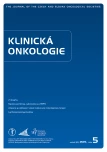Peritoneal Carcinomatosis of Gastric Origin – Treatment Possibilities
Authors:
David Hoskovec 1; Zdeněk Krška 1; Petr Dytrych 1; Michal Vočka 2
Authors‘ workplace:
I. chirurgická klinika 1. LF UK a VFN, Praha 2 Onkologická klinika 1. LF UK a VFN, Praha
1
Published in:
Klin Onkol 2019; 32(5): 345-348
Category:
Review
doi:
https://doi.org/10.14735/amko2019345
Overview
Background: Peritoneal carcinomatosis of gastric origin is challenging to diagnose and treat. This disease is often misdiagnosed in the early stages using a non-invasive technique. Conventional surgery is unsuitable for treatment of patients with peritoneal seeding and positive peritoneal cytology. Peritoneal recurrence is the most frequent cause of therapeutic failure. The effectiveness of chemotherapy is low due to the plasma-peritoneal barrier. Cytoreductive surgery combined with hyperthermic intraperitoneal chemotherapy (HIPEC) is the standard treatment for pseudomyxoma peritonei and mesothelioma and improves overall survival and disease-free survival. This approach is also widely used to prevent and treat peritoneal carcinomatosis of gastric origin.
Purpose: This article aims to provide a short summary of the contemporary role of cytoreductive surgery and HIPEC for treatment of gastric cancer patients. Theoretically, there are four possible applications and indications. First, palliative application to improve quality of life without prolongation of overall survival. This application mainly affects malignant ascites. Second, therapeutic application using a combination of gastrectomy/cytoreductive surgery and HIPEC to treat advanced disease including peritoneal metastases. Localized peritoneal seeding is the only indication for this application (maximum peritoneal cancer index of 10–12 or Cy+). Third, adjuvant/prophylactic application in patients at high risk of peritoneal recurrence, typically those with T3, T4, N+ disease (without peritoneal seeding). Fourth, neoadjuvant application using a combination of repeated HIPEC and chemotherapy with the aim of decreasing peritoneal seeding and enabling radical surgery. In this indication, HIPEC is often replaced by pressurized intraperitoneal aerosol chemotherapy.
Keywords:
peritoneal metastases – cytoreductive surgery – hyperthermic intraperitoneal chemotherapy – Gastric cancer
Sources
1. Rihuete Caro C, Manzanedo I, Pereira F et al. Cytoreductive surgery combined with hyperthermic intraperitoneal chemotherapy (HIPEC) in patients with gastric cancer and peritoneal carcinomatosis. Eur J Surg Oncol 2018; 44 (11): 1805–1810. doi: 10.1016/j.ejso.2018.06. 036.
2. Leiting JL, Grotz TE. Optimizing outcomes for patients with gastric cancer peritoneal carcinomatosis. World J Gastrointest Oncol 2018; 10 (10): 282–289. doi: 10.4251/wjgo.v10.i10.282.
3. Seshadri RA, Glehen O. The role of hyperthermic intraperitoneal chemotherapy in gastric cancer. Indian J Surg Oncol 2016; 7 (2): 198–207. doi: 10.1007/s13193-016-0502-8.
4. Hoskovec D, Varga J, Konečná E et al. Levels of CEA and Ca 19-9 in the sera and peritoneal cavity in patients with gastric and pancreatic cancers. Acta Cir Bras 2012; 27 (6): 410–416.
5. Japanese Gastric Cancer Association. Japanese gastric cancer treatment guidelines 2014 (ver. 4). Gastric Cancer 2017; 20 (1): 1–19. doi: 10.1007/s10120-016-06 22-4.
6. AWMF online. Das Portal der wissenschaftlichen Medizin. Magenkarzinom – Diagnostik und Therapie der Adenokarzinome des Magens und ösophagogastralen Übergangs. [online]. Available from: https: //www.awmf.org/uploads/tx_szleitlinien/032-009l_S3_Magenkarzinom_Diagnostik_Therapie_Adenokarzinome_oesophagogastraler_Uebergang_2012-abgelaufen.pdf.
7. Modrá kniha České onkologické společnosti. Masarykův onkologický ústav 2019.
8. National Comprehensive Cancer Network. Gastric Cancer. NCCN Guidelines Version 2.2018. [online]. Available from: https: //www.nccn.org/professionals/physician_gls/pdf/gastric.pdf.
9. Smyth EC, Verheij M, Allum Wn et al. Gastric cancer: ESMO Clinical Practice Guidelines for diagnosis, treatment and follow-up. Ann Oncol 2016; 27 (Suppl 5): 38–49. doi: 10.1093/annonc/mdw350.
10. De Manzoni G, Marrelli D, Baiocchi GL et al. The Italian Research Group for Gastric Cancer (GIRCG) guidelines for gastric cancer staging and treatment: 2015. Gastric Cancer 2017; 20 (1): 20–30. doi: 10.1007/s10120-016-06 15-3.
11. Alberto M, Brandl A, Garg PK et al. Pressurized intraperitoneal aerosol chemotherapy and its effect on gastric-cancer-derived peritoneal metastases: an overview. Clin Exp Metastasis 2019; 36 (1): 1–14. doi: 10.1007/s10585-019-09955-4.
12. Fujimoto S, Shrestha RD, Kokubun M et al. Intraperitoneal hyperthermic perfusion combined with surgery effective for gastric cancer patients with peritoneal seeding. Ann Surg 1988; 208 (1): 36–41. doi: 10.1097/00000658-198807000-00005.
13. Glehen O, Gilly FN, Arvieux C et al. Peritoneal carcinomatosis from gastric cancer: a multi-institutional study of 159 patients treated by cytoreductive surgery combined with perioperative intraperitoneal chemotherapy. Ann Surg Oncol 2010; 17 (9): 2370–2377. doi: 10.1245/s10434-010-1039-7.
14. Coccolini F, Cotte E, Glehen O et al. Intraperitoneal chemotherapy in advanced gastric cancer. Meta-analysis of randomized trials. Eur J Surg Oncol 2014; 40 (1): 12–26. doi: 10.1016/j.ejso.2013.10.019.
15. Yonemura Y, Canbay E, Li Y et al. A comprehensive treatment for peritoneal metastases from gastric cancer with curative intent. Eur J Surg Oncol 2016; 42 (8): 1123–1131. doi: 10.1016/j.ejso.2016.03.016.
16. Murata S, Kaida S, Kodama H et al. A propensity-matched analysis comparing hepatic recurrence after curative gastrectomy followed by adjuvant HIPEC to surgery alone for advanced gastric cancer. J Clin Oncol 2016; 34 (Suppl 15): 4056–4056.
17. Desiderio J, Chao J, Melstrom L et al. The 30-year experience – a meta-analysis of randomised and high-quality non-randomised studies of hyperthermic intraperitoneal chemotherapy in the treatment of gastric cancer. Eur J Cancer 2017; 79: 1–14. doi: 10.1016/j.ejca.2017.03. 030.
18. Kitayama J, Ishigami H, Yamaguchi H et al. Treatment of patients with peritoneal metastases from gastric cancer. Ann Gastroenterol Surg 2018; 2 (2): 116–123. doi: 10.1002/ags3.12060.
Labels
Paediatric clinical oncology Gastroenterology and hepatology Surgery Clinical oncologyArticle was published in
Clinical Oncology

2019 Issue 5
- Metamizole vs. Tramadol in Postoperative Analgesia
- Metamizole at a Glance and in Practice – Effective Non-Opioid Analgesic for All Ages
- Possibilities of Using Metamizole in the Treatment of Acute Primary Headaches
- Current Insights into the Antispasmodic and Analgesic Effects of Metamizole on the Gastrointestinal Tract
- Spasmolytic Effect of Metamizole
Most read in this issue
- Alopecia and Hair Damage Induced by Oncological Therapy
- Pseudomyxoma Peritonei
- Treatment of Malignant Peritoneal Mesothelioma
- Malignant Peritoneal Tumors – Introduction
